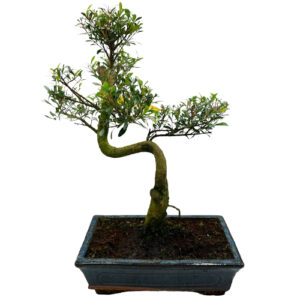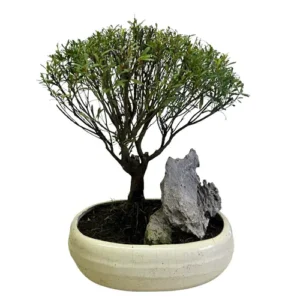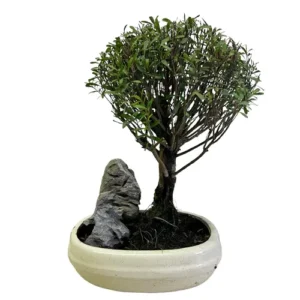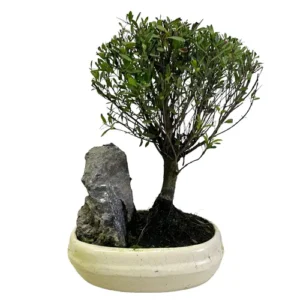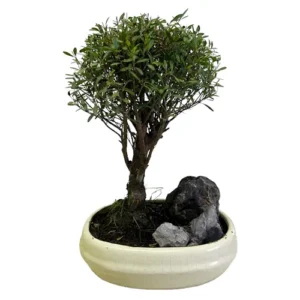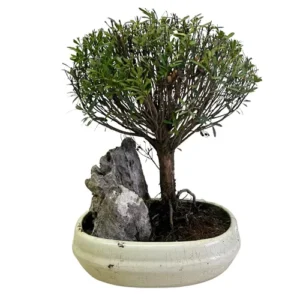Myrtus Communis
Chinese Myrtle Bonsai
The Chinese myrtle is native to the Mediterranean and some parts of Northern Africa. Myrtles have small, fragrant white flowers which turn into a dark coloured fruit that can be used to make liqueur. The Ancient Greeks and Romans associated this plant with love and marriage, making it a popular choice for bridal bouquets.
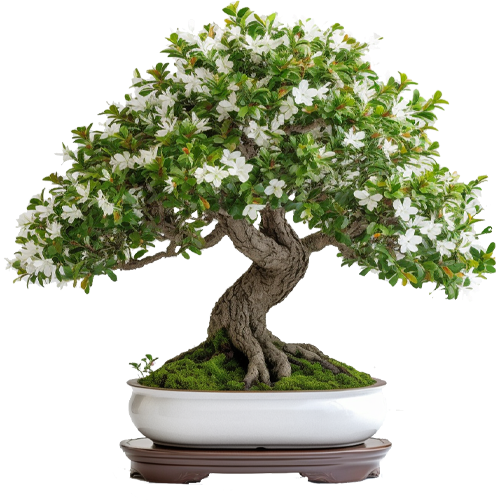
Chinese Myrtle Bonsai Care Tips
Placement
Chinese myrtle bonsai trees can be grown both indoors and outdoors, depending on where you live: in the UK it is best kept indoors but then placed outside during hot and sunny days as it likes a lot of air and light. If placing outside, choose a location that receives ample sunlight throughout the day, but provide semi-shade during the midday when the sun is at its strongest to prevent leaf burn. In the autumn, winter and early spring months, protect your tree from temperatures that fall below 10 °C by bringing it inside.
If placing indoors, choose a windowsill that gets plenty of sunlight. Chinese myrtle bonsai trees can tolerate low light conditions, but this may result in slower growth and discolouration of the leaves. If you need to place your bonsai tree in a location with lower light levels, consider supplementing with artificial grow lights and horticultural heaters. The Chinese myrtle can withstand high temperatures of up to 40 °C but not cold temperatures.
Watering
There is no definitive guide to watering and it should be conducted on an observational schedule, not a routine. This means that it is important to keep an eye on the moisture levels of the soil to avoid over and under watering, both which can lead to dropping leaves and/or root death. The amount of water a bonsai requires depends on pot size, climate, airflow, soil and tree type so it is best to use your eyes and fingers to assess whether the soil is damp, wet or dry.
If the top inch or so of soil has dried, it is ready to be watered. When you water, try to get an even coverage over the roots and soil, allowing water to flow out from the bottom of the pot to ensure a good soaking.
If you are a first-time bonsai owner, another way to water is by submerging the entire pot in water until the bubbles stop. If you choose this method, be aware that your bonsai may not need watering for another two to four days, but this will depend on the factors mentioned above such as soil type, pot size and climate.
The Chinese myrtle does not tolerate high concentrations of lime well so if you live in a hard water area it is best to use rainwater where possible. To balance the high heat required by a myrtle, most of which can be very drying when inside the house, place the bonsai on top of a tray of water that is filled with gravel (to stop the bottom of the pot sitting in water). When this water evaporates it will create a humid environment around the tree.
Feeding & Fertilizing
Using fertiliser on your Chinese elm will help encourage healthy growth and this should be done periodically from once a week to every two months and only during the growing season. You can start adding Chrysal Liquid Bonsai Feed to your water from March until October and use weekly. Use Naruko Fertiliser Slow Release Bonsai Feed once every one to two months. With bonsai trees, less is more, and we tend to advise using half the recommended dosage to see how your bonsai reacts first.
Pruning & Wiring
Pruning your bonsai is important not only to maintain or create an aesthetic style but to also ensure light and airflow can reach inner foliage. The Chinese myrtle thickens rapidly and frequent trimming will produce a dense network of fine branches (ramification). To do this, after flowering, use appropriate tools to cut back stems which have grown longer than at least six to eight leaves, leaving the two leaves which are closest to the stem intact to ensure new buds will be produced.
Training your bonsai using wiring is easy when working with the younger shoots, but older shoots of the Chinese myrtle can crack and break, requiring more care and risk. We recommend using wires with a thickness that matches the thickness of the branch: if the wire you choose is too thick you will damage the bark. If it is too thin, it won’t be effective
Repotting
Repotting your tree is an important way to provide a fresh and suitable soil mix and ensure appropriate root health. Repot in early spring. Generally, your Chinese myrtle will need to be re-potted once every two or three years if it is young, while older ones can stay in their pots for longer. However, you should always check if it has become root-bound before you change pots. You can do this by lifting the tree gently out of the pot by the main trunk and examining the root system. You will know it is ready if you can see that the roots are circling around each other and the pot. If, however, they still appear contained in the soil, you should place it back and wait until the following spring to check again. Your Chinese myrtle will produce more flowers if it is a little root bound.
Trees that are ready for repotting will require root pruning, a suitable new pot and appropriate soil mix. For a step-by-step guide on these topics please visit www.miyagibonsai.co.uk/blog/
The Chinese myrtle has roots that must be pruned with care and it is important that the soil mix you choose for the new pot is lime-free and well-draining. We tend to use a mixture of different speciality bonsai soils on our trees. Every species is different so please contact us for free soil-mix advice or to take advantage of our re-potting service, visit www.miyagibonsai.co.uk/services.
Bonsai make for a one-of-a-kind indoor plant offering elegance, nature and art all in one minute form. Across an array of exquisite and erudite species, they all demand their own specific care and cultivation needs in order for their beauty to flourish. We have an extensive library of care guides for indoor bonsai trees so you can make an informed and considered choice. It’s not about selecting the perfect bonsai, it’s about selecting the perfect bonsai for you.
Chinese Myrtle Bonsai - Typical Queries
How to propagate my Chinese Myrtle Bonsai?
You can propagate your Chinese Myrtle Bonsai by seeds, cuttings, or air-layering. Seeds can be collected from the ripe fruit, and sown in moist soil. Cuttings can be taken from young and healthy shoots, and planted in moist soil or water. Air-layering can be done by making a small cut on a branch, and wrapping it with moist sphagnum moss and plastic. After a few months, roots will form, and the branch can be cut off and potted.
How to deal with pests and diseases on my Chinese Myrtle Bonsai?
The most common pests and diseases that affect Chinese Myrtle Bonsai are aphids, spider mites, scale insects, mealybugs, fungal infections, and root rot. You can prevent them by keeping your tree healthy, clean, and well-ventilated. You can treat them by spraying your tree with a mild insecticide or fungicide, or by using natural remedies such as neem oil, soap water, or vinegar. You can also remove the infected parts with a sterile tool, and repot your tree if necessary.
What are the benefits of having a Chinese Myrtle Bonsai?
- Having a Chinese Myrtle Bonsai can bring you many benefits, such as:
- Improving your mental and physical health, by reducing stress, enhancing mood, boosting creativity, and purifying the air.
- Adding beauty and elegance to your home, office, or garden, by creating a focal point, a conversation piece, or a personal touch.
- Learning a new and rewarding hobby, by developing your skills, knowledge, and patience, and by connecting with nature and culture.

